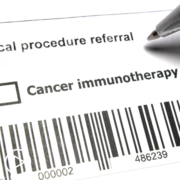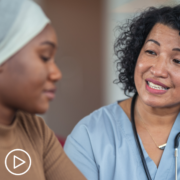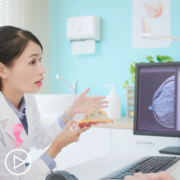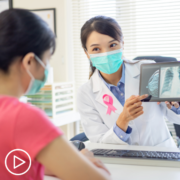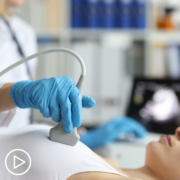Becoming an Empowered and [ACT]IVATED Breast Cancer Patient
Patient Empowerment Network (PEN) is committed to helping educate and empower patients and care partners in the breast cancer community. Breast cancer treatment options are ever-growing with research advancements in treatments and testing, and it’s important for patients and families to educate themselves with health literacy tools and resources on the latest information in breast cancer care. With this goal in mind, PEN kicked off the [ACT]IVATED Breast Cancer program, which aims to inform, empower, and engage patients to stay abreast of up-to-date information in breast cancer care.
The [ACT]IVATED Breast Cancer program is aimed at newly diagnosed breast cancer patients, yet it is beneficial at any stage of disease. [ACT]IVATED Breast Cancer helps patients and care partners stay in the know about the latest options for their breast cancer, provides patient activation tools to help overcome barriers to accessing care, and powerful tips for self-advocacy, coping, and living well with cancer.
Breast Cancer Disparities
With more focus on disparities in breast cancer outcomes, research studies are starting to reveal actionable information on genetic differences. A recent study uncovered a racial disparity among cancer types that are hormone receptor-negative but HER2-positive. While treatment has been successful in white patient groups, the outcomes have been less successful in Black patient groups. The study also noted key gene mutations in the MAPK pathway occur more frequently in Black patients, which warrants further investigation.
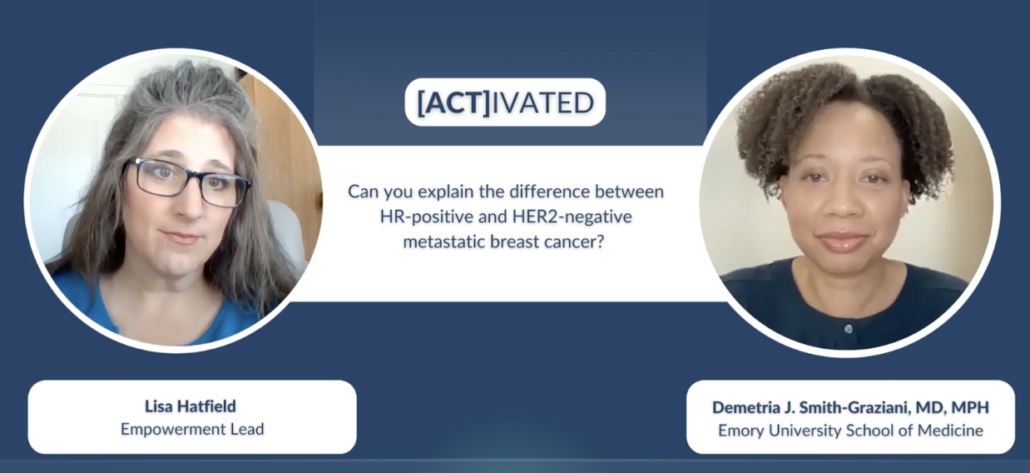
Breast cancer expert Dr. Demetria Smith-Graziani from Emory University School of Medicine shared updates about her breast cancer research. “…what we found is that regardless of the type surgery Black women were reporting more severe pain compared to white women, and so that’s what prompted me to engage in my most recent research project…the reason that I’m looking at those specific set of factors is because there are a number of psychological components to the way that we feel pain, such as anxiety, depression and yes trust that are linked to the way that we experience pain and how severe that pain is and how much that pain affects our lives.
Proactive Steps to Improve Breast Cancer Care
Knowledge gained from research studies can be utilized by patient advocates, and actions can be taken to improve breast cancer care and in the evolution of research efforts for all patients. Dr. Smith-Graziani discussed the importance of clinical trials in driving advancements in breast cancer research and treatments. “…all of the current treatments we have that are FDA-approved were approved because of the results from clinical trials that previous patients participated in…And we won’t get any new advancements in breast cancer treatments and come up with even better, more effective treatments, unless we are able to do more clinical trials with more patients. The other part is that in the past, most of the participants of clinical trials have been pretty much the same, they have been mostly white, mostly have insurance, mostly of a higher socioeconomic status, and those patterns continue today, we are still trying to get the patients in clinical trials to reflect the true population of the United States. And in order to know that clinical trials are effective for everybody, we need to have everybody in those trials.”
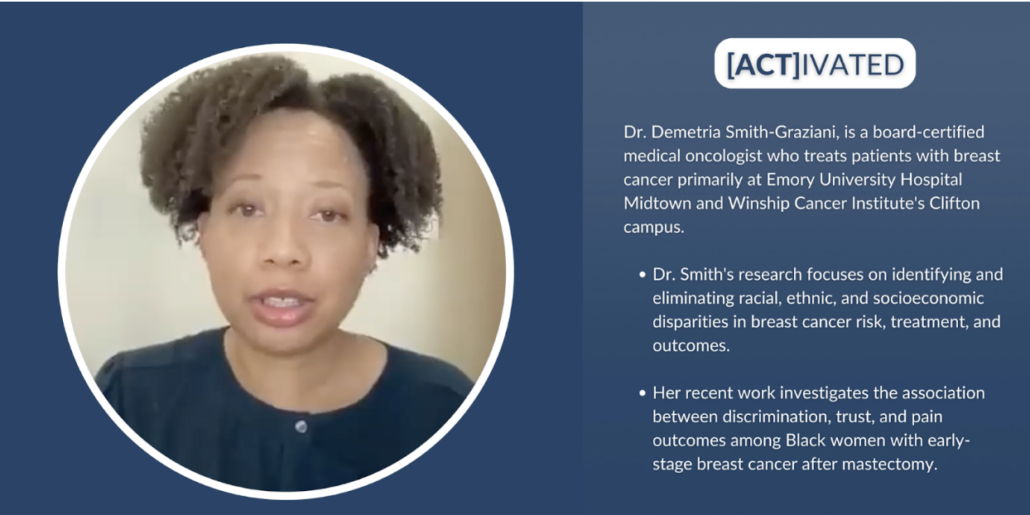
Dr. Smith-Graziani also explained breast cancer subtypes and why it’s vital for patients to learn about their breast cancer subtype. “When we are looking at the cancer cells under the microscope, we look at specific proteins in these cells, and based on what proteins we see, we designate it as positive or negative for the estrogen receptor, the progesterone receptor, or a protein called HER2. When a cancer expresses the estrogen or progesterone receptor, that means that it feeds off of those hormones that your body makes, and that’s why we refer to it as hormone receptor-positive…And it’s important that we know what subtype of breast cancer you have, because it affects the type of treatment that you can get.”
Learning about family history of cancer is also another key to staying proactive in breast cancer care. Dr. Smith-Graziani explained, “So breast cancer definitely can be hereditary, we are aware of some forms of inherited breast cancers, and we have identified certain mutations in genes that are passed down along family lines, that increase the risk of getting breast cancer…ask your family members about their cancer history so that you’re aware of it, and then ask your oncologist if they recommend genetic counseling or testing.”
Another fundamental step in proactive breast cancer care is for patients to ask about their treatment plan. Dr. Smith-Graziani shared advice for patients. “…in addition to potential side effects are how long is my treatment meaning how long am I going to have to stay in the infusion center if I’m getting an IV medication? Or how many months of treatment do I need to get? And then how much time do I need to take off of work? Am I going to be able to work while getting my treatment, so it’s those little things which aren’t so little that are important to discuss, so that the patients can get the best overall picture about how each treatment will affect them in the short and the long term.”
Dr. Smith-Graziani stressed the value of getting your questions answered and also the value of additional expert opinions. “I think it’s important for patients to be as informed as possible to make sure that they are getting all of their questions answered by their doctor, and if you don’t feel like your questions are getting answered, if you don’t feel like your concerns are being appropriately addressed or acknowledged, please make sure that you get a second or a third opinion and talk to another doctor to see if they can answer your questions.”
[ACT]IVATED Breast Cancer Program Resources
The [ACT]IVATED Breast Cancer program series informs, empower, and engage both the overall community and breast cancer patient groups who experience health disparities. The series includes the following resources:
[ACT]IVATED Expert Interviews
- Noted Racial, Ethnic, and Socioeconomic Disparities In Breast Cancer Outcomes
- What Is High-Risk Breast Cancer?
- How Is Breast Cancer Explained to Newly Diagnosed Patients?
- Practical Questions About Breast Cancer Treatment Patients Should Ask
- Eliminating Disparities in Breast Cancer | Tips for Navigating Inequities
- What Is Node-Positive and Node-Negative Breast Cancer?
- An Overview of Breast Cancer Subtypes: Tips for Being Proactive
- How Does Hormone Therapy Impact Breast Cancer Treatment?
- Pain Outcomes Among Black Women with Early Stage Breast Cancer After Mastectomy
- Is My Breast Cancer Hereditary?
- The Role of Immunotherapy for Metastatic Breast Cancer or Relapse
- Emerging Treatments In Breast Cancer: Are Antibody Drug Conjugates Here to Stay?How Advancements in Breast Cancer Are Driven By Clinical Trials
- What Treatments Are Available for HER2-Positive Metastatic Breast Cancer?
[ACT]IVATED Resources
Though there are breast cancer disparities, patients and care partners can be proactive in educating themselves to help ensure optimal care. We hope you can take advantage of these valuable resources to aid in your breast cancer care for yourself or for your loved one.
[ACT]IVATION Tip:
By texting EMPOWER to +1-833-213-6657, you can receive personalized support from PENs Empowerment Leads. Whether you’re a breast cancer patient, or caring for someone who is, PEN’s Empowerment Leads will be here for you at every step of your journey. Learn more.
Share Your Feedback:
Create your own user feedback survey



